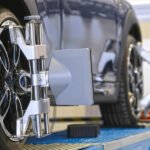

How a Car Ignition System Works
1. Key in the Ignition:
When the key is inserted into the ignition switch, a crucial electrical event is initiated. Turning the key completes the ignition circuit, signaling the start of the engine’s initiation process.
2. Turning the Key:
As the key is turned, it acts as a mechanical switch, closing the circuit between the car’s battery and the ignition system. This action initiates a sequence of events that culminate in the engine starting.
3. Battery Sends Power:
The car’s battery, typically a 12-volt system, is now engaged. It sends electrical power through the ignition switch, kickstarting the ignition process.
4. Starter Motor Activation:
The electrical power is directed to the starter motor, a powerful electric motor responsible for physically turning the engine over. This process is analogous to using a kickstarter to initiate the rotation of the internal combustion engine.
5. Fuel and Air Mixture:
Concurrently, the fuel injection system begins its operation, spraying a precisely measured mist of fuel into the engine’s cylinders. Simultaneously, the air intake system draws in the necessary air, setting the stage for combustion.
6. Compression Stroke:
One of the engine’s cylinders enters the compression stroke, where the piston compresses the fuel-air mixture within the confined space of the cylinder. This compression raises the temperature and pressure, preparing the mixture for ignition.
7. Spark Plug Ignition:
Here, the ignition coil, acting as an energy transformer, intensifies the electrical power and channels it to the spark plug. The spark plug, in turn, creates a spark, serving as the ignition source for the highly compressed fuel-air mixture.
8. Combustion Explosion:
The ignited mixture undergoes a rapid and controlled combustion, resulting in a controlled explosion within the cylinder. This explosion generates force that drives the piston down in the power stroke, initiating the engine’s rotation.
9. Engine Turns Over:
This cyclic process repeats across multiple cylinders, causing the engine to turn over continuously. The synchronized operation of multiple cylinders ensures the sustained operation of the engine.
10. Alternator Powers Up:
Once the engine is running, the role of providing electrical power shifts from the battery to the alternator. The alternator generates electrical energy from the rotating motion of the engine, supplying power to the various electrical components and systems in the car.
Example: Consider the spark plug as a precision instrument, akin to a miniature lightning bolt. Its role is to ignite the fuel-air mixture with precision and control, setting off a series of meticulously timed explosions that power the engine and propel the vehicle.
Add a comment Cancel reply
Categories
- Car Gadgets (17)
- Car News (33)
- Car Reviews (43)
- Car Wars (7)
- Mechanicals (32)
- Uncategorized (2)
Recent Posts
About us

Popular Tags
Related posts


Essential Car Repair Skills Every Driver Should Know

All About Wheel Balancing








